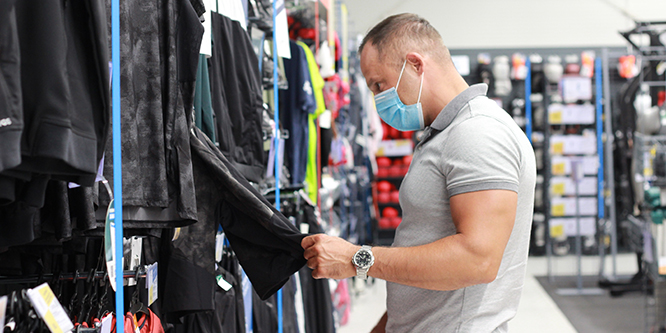
Photo: @nataliazera via Twenty20
August 5, 2020
Will shortages shortchange soft goods recovery?
Crocs, known for its squishy sandals, announced that its sales in the back half of 2020 will be held back, not due to COVID-19-related sales weaknesses, but because of likely inventory shortfalls.
“These inventory constraints are deliberate,” said Andrew Rees, president and CEO, last Thursday on a conference call with analysts. In March as the pandemic emerged, Crocs significantly canceled orders on summer deliveries to best manage working capital and preserve full holiday units.
Second-quarter revenues then came in better than expected. Sales in the quarter were down only six percent on a currency-neutral basis as strong online sales through crocs.com and third-party sites nearly offset the impact of store closures. Regionally, four-out-of-five key geographies — the U.S., Korea, China, and Germany — delivered revenue growth.
Despite sales growth accelerating as stores re-opened, Crocs is projecting flat sales in the second half due to the low inventory levels. Further, Crocs will not aggressively restock due to uncertainties created by the pandemic, the potential expiration of stimulus programs and high unemployment. Said Mr. Rees, “While we are reacting to shortages in core inventory, we feel it is more important to keep inventory lean and to turn up the majority of our focus to 2021.”
Crocs was among many apparel and footwear companies that canceled or deferred orders as stores temporarily closed, although the majority fared worse in the second quarter with quarterly declines in the 40 percent range.
Under Armour likewise said that because it significantly reduced planned inventory purchases in April and May, it “may not have adequate supply” should the second half recover better than expected.
The inventory constraints were part of the reason Under Armour’s is expecting sales in the second half to decline in the range of 20-to-25 percent. The athletic brand also cited an expected “highly promotional” environment as elevated industry-wide inventories tied to store closures are worked down as well as concerns over weak in-store traffic trends. CEO Patrik Frisk told CNBC on Friday, “The consumer is there, but they are still nowhere near pre-COVID levels … there is hesitancy there.”
- Crocs, Inc. Reports Fiscal 2020 Second Quarter Results – Crocs
- Crocs Q2 2020 Earnings Call Transcript – Motley Fool
- Under Armour Reports Second Quarter 2020 Results – Under Armor
- Under Armour Q2 2020 Earnings Call Transcript – Motley Fool
- Under Armour CEO Patrik Frisk says ‘tentative’ shoppers are here to stay thanks to pandemic – CNBC
Discussion Questions
DISCUSSION QUESTIONS: What’s the likelihood that inventory shortages in apparel and footwear will be a recurring theme in third and fourth quarter results? Were the moves by many to reduce orders prudent or overly cautious? Should soft foods vendors aggressively restock?
Poll
BrainTrust
Steve Dennis
President, Sageberry Consulting/Senior Forbes Contributor
Rich Kizer
Principal, KIZER & BENDER Speaking
Recent Discussions








The predominant issue for most of the apparel sector is a glut of inventory, a lot of it resulting from a dramatic slump in sales from the past quarter. Demand is now recovering, but it remains significantly down from last year and will continue to do so for the foreseeable future. Even though a lot of retailers have cut orders, I do not see a supply shortage being a major issue for the balance of 2020. That said, there will be some popular brands where there are shortages.
As for Under Armour, it says it has an inventory shortage and then in the next breath says it has to promote. If the brand is in demand and there is a shortage of supply, you don’t need to promote. The narrative doesn’t really make much sense.
This will be a recurring theme throughout the remainder of 2020. During these unpredictable times, retailers need to place bets, and inventory levels is a big one. Have too much and you tie-up vital cash; have too little and sales fall flat with nothing to sell. I don’t envy the retailers that have to make these difficult decisions. While there is no way to predict outcomes, retailers need to remain cautious and, most importantly, flexible.
Many manufacturing facilities have also been affected by the pandemic, not just retail stores. To the extent that factories can reopen safely, the shortages may be managed. Seasonal inventory may have sat in stores waiting to be sold, and that probably didn’t happen. New product (non-staples) will be slower in coming.
This is likely to be a decidedly mixed bag but pockets of “broken assortments” will absolutely emerge.
In general there is a glut of inventory and for retailers selling less fashion forward and less seasonable items — think more all weather basics — few shortages should emerge and many brands will struggle to achieve adequate sell-through and margins.
For true fall fashion and strong cold weather items — think coats, heavy sweaters and the like — out-of-stocks are definitely possible since so many retailers dramatically cut orders as the pandemic took hold. For retailers that are strongly private brand oriented, it is next to impossible to “chase demand” given the long lead times for product produced overseas. They have essentially bought sales decreases.
While the supply side is easier to understand, more serious and complicated is the question of what the impact of demand will be. At this point, given the general backdrop of a poorly controlled outbreak, a continued strong work-from-home trend and back-to-school being lackluster at best, demand is likely to be tepid enough that material inventory shortages are likely to be fairy isolated.
It looks like businesses are hedging their bets and there is not really a supply chain constraint. Given that the past four months have been better than normal for certain categories, meeting the original yearly goal is still possible for these businesses. In that sense, they can afford to take a more conservative view and not commit to lot of inventory buys. Of course this runs the risk of ceding the ground to competition, but that is for each business to decide. It is possible that such pull back will bite them – particularly if they had the ability to invest yet chose to stay conservative.
Aggressively restock? Absolutely not. An abundance of inventory with the wrong season is a big problem right now.
Next, apparel and footwear is too broad. If you segment to athleisure and sportswear, then Under Armour (and Nike, etc) share similar challenges. It’s summer time, many are working from home or wearing more “comfortable clothes.”
Crocs is a bit of an anomaly. They are like the Mini Cooper of shoes. So segment the footwear category to athletic/leisure/casual and business/dress and you’ll find something similar.
I haven’t worn brown dress shoes in five months. Haven’t worn a sport jacket either. That’s likely why brands like Brooks Brothers are in trouble. On the flip side, I’m burning through sneakers…
I don’t know about shortages – I think there is an over-inventory situation as may retailers had already received their spring and summer lines when the pandemic hit. Right now it is a shot in the dark ordering winter and fall items and yes there may be some shortages in those items, but then who wants to take a bath in more inventory that they may not be able to sell through? Those that did sell through their spring and summer wear (at least where I am) are holding their fall and winter wear over to the next year and you have empty store racks.
Seasonal retailers will likely see the greatest impacts as they would have been the most reliant on new orders placed in the last several months for holiday 2020 merchandise, coupled with an inability to move excess spring and summer merchandise. With global supply chains disrupted since January, there will indeed be lots of retailers impacted from an inventory perspective. The lack of supply could in theory drive demand for several categories, but will likely end up resulting in a lesser number of promotions for those with limited stock.
How many times will a customer walk into a favorite store and not see new, clean product in quantities expected, and leave happy? Even if the older stuff that has already been viewed is there? I have always been of the opinion that lowering inventories beyond reasonable levels will have a significant negative impact on sales — and turn. The solution to a problem should never make the problem larger. Be careful with our incredibly smart and demanding customers.
It’s not shortages, it’s conservative planning. While retailers hate to miss any possible sale, executing on a conservative plan, banking every gross margin dollar, and sticking to the planned inventory cash investment is sound business. If there’s some upside to chase — great, that works for some shorter lead time products. If not this is a much better place to be than figuring out how to sell excess stock into a glut.
Right now it’s impossible to plan or even guess at needed inventory for the next six to 12 months. So absolutely the prudent thing to do is to go lean until business, and health, conditions provide more clarity. Several recent visits to Target showed understocked conditions throughout the store. So manufacturing and supply chain management has challenges everywhere. It’s not just about customer and shopping conditions here. It’s also about raw material availability and manufacturing conditions in countries of origin. This won’t sort out for a while.
Those brands and retailers that tried to plan for an expected drop in revenue in the early stages of the pandemic are surprised that people have not stopped their purchasing behavior. In many categories, sales have been beyond anyone’s expectations. And this goes way beyond apparel. Consumer goods, including staples and durables, are in out-of-stock conditions throughout the country. I suppose that good news is that demand is keeping these businesses busy. However, with traditional product lead times, out-of-stocks will be here for a while.
Currently inventory shortages (or in most cases having the inventory in the right place) are a major challenge for every retail vertical. This is translating to poor customer experience during many in-store shopping journeys for consumers across all verticals. This is important since consumers do not think in verticals they think in brands. This sets the table for retailers who have the right inventory mix at the right place at the right time to make a lasting positive impression. Soft goods and footwear vendors need to be bold and pick the season that they are going to be “in stock” in and commit to it. In parallel they need to shorten their product life cycle and improve supply chain visibility so that they can use their physical locations to fill any order.
I think it will be spotty because some categories have a glut in inventory, like workwear, while leisure and workout wear (whether people are really working out in it is a different question) probably moved online and stores like Target and Walmart were open the entire time. Some categories have faced a restock issue given factory closures (in this case Crocs is also being cautious, I am sure, even as more people bought Crocs for wearing at home) but others face a glut of out-of-season inventory.
Retailers are looking to conserve cash and reduce inventory. Reducing inventory holding costs is an inherent way to recover cash. Offering up lean inventory and inventory caps will continue into Q3/Q4 across various companies. Are/were they overly cautious? Maybe, but the effects of the pandemic are/were unpredictable. This is a hedge against too much inventory purchasing to reduce business risk at the cost of volume and growth. A bump and recovery in Q3/Q4 will result in some companies missing opportunity for growth, but the these companies are betting on the downside.
In my neighborhood there aren’t a lot of shorts to be found, but there are many hundreds of evening gowns. This is going to take a long time to sort out, and our ongoing nonresponse to COVID doesn’t bode well for 2021, either.
I agree with a lot of the discussion points. I think there is a glut of stock in certain categories and shortages in other categories. Buying and Merchandise teams have spent many hours replanning over the last few months. The challenge is the volatility of demand. Will there still be social events like Christmas get togethers and so people will buy party products like last year, or will there still be the trend for casual? What will happen to outerwear if people are not going out so much and these generally have longer lead times? As Columbus talks to its retail customers, these are the types of challenges they are facing and how can they be set up to react flexibly when the demand flexes.
To be sure, there will be BOTH excess inventory and shortages. In the seasonal and fashion space, disruption to consumer seasonal buying patterns as well as shifts in mix put a lot of inventory in the wrong place at the wrong time. Successful merchandising is driven by a well-managed flow of inventory. Leading retailers look at their inventory the way banks look at their loan portfolios: Some products are low risk (albeit lower returns) and other products are high risk/high reward. Reaction, especially in a time of disruption, cannot be one size fits all. Already we see strong indicators on products that maintain or grow share: basics, wear at home, wear now, comfort purchases. Other luxury, status or social categories have no demand at any price. Negotiating these inventory commitments is especially tricky in this time period and may take new tools and skills.
Most companies would do better with a shortage of inventory, as long as it is they are short in the “right” inventory. This requires maintaining a delicate balance of fashion and core items. Lower inventories should help companies maintain higher margins as they will be — or should be — then less promotional. Basic supply and demand economics. As an industry, we need to ween ourselves off the “more is better” is mindset. Less inventory, less assortment, less stores, less friction. It all is part of right-sizing our businesses to profitable levels, that can sustain realistic growth on the go forward. The big shakeout is on.